
Kohlrabi, also called German turnip or turnip cabbage, is a biennial vegetable, a low, stout cultivar of wild cabbage. It is a cultivar of the same species as cabbage, broccoli, cauliflower, kale, Brussels sprouts, collard greens, Savoy cabbage, and gai lan.

Cabbage, comprising several cultivars of Brassica oleracea, is a leafy green, red (purple), or white biennial plant grown as an annual vegetable crop for its dense-leaved heads. It is descended from the wild cabbage, and belongs to the "cole crops" or brassicas, meaning it is closely related to broccoli and cauliflower ; Brussels sprouts ; and Savoy cabbage.

Broccoli is an edible green plant in the cabbage family whose large flowering head, stalk and small associated leaves are eaten as a vegetable. Broccoli is classified in the Italica cultivar group of the species Brassica oleracea. Broccoli has large flower heads, or florets, usually dark green, arranged in a tree-like structure branching out from a thick stalk, which is usually light green. The mass of flower heads is surrounded by leaves. Broccoli resembles cauliflower, which is a different but closely related cultivar group of the same Brassica species.
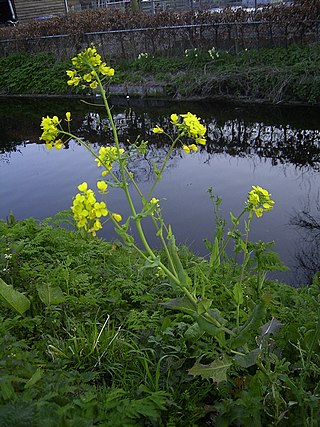
Brassica is a genus of plants in the cabbage and mustard family (Brassicaceae). The members of the genus are informally known as cruciferous vegetables, cabbages, mustard plants, or simply brassicas. Crops from this genus are sometimes called cole crops—derived from the Latin caulis, denoting the stem or stalk of a plant.

Cauliflower is one of several vegetables cultivated from the species Brassica oleracea in the genus Brassica, which is in the Brassicaceae family.
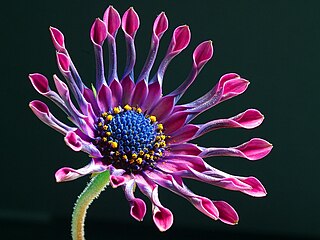
A cultivar is a kind of cultivated plant that people have selected for desired traits and which retains those traits when propagated. Methods used to propagate cultivars include division, root and stem cuttings, offsets, grafting, tissue culture, or carefully controlled seed production. Most cultivars arise from deliberate human manipulation, but some originate from wild plants that have distinctive characteristics. Cultivar names are chosen according to rules of the International Code of Nomenclature for Cultivated Plants (ICNCP), and not all cultivated plants qualify as cultivars. Horticulturists generally believe the word cultivar was coined as a term meaning "cultivated variety".

Rapeseed, also known as rape and oilseed rape, is a bright-yellow flowering member of the family Brassicaceae, cultivated mainly for its oil-rich seed, which naturally contains appreciable amounts of erucic acid. The term "canola" denotes a group of rapeseed cultivars that were bred to have very low levels of erucic acid and which are especially prized for use as human and animal food. Rapeseed is the third-largest source of vegetable oil and the second-largest source of protein meal in the world.

The Brussels sprout is a member of the Gemmifera cultivar group of cabbages, grown for its edible buds.
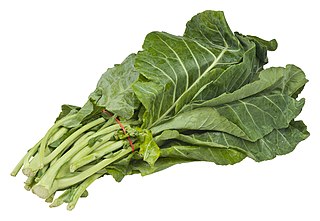
Collard is a group of loose-leafed cultivars of Brassica oleracea, the same species as many common vegetables including cabbage and broccoli. Part of the Acephala (kale) cultivar group, it is also classified as the variety B. oleracea var. viridis.

Kale, also called leaf cabbage, belongs to a group of cabbage cultivars primarily grown for their edible leaves. It has also been used as an ornamental plant.

Chinese cabbage is either of two cultivar groups of leaf vegetables often used in Chinese cuisine: the Pekinensis Group and the Chinensis Group.
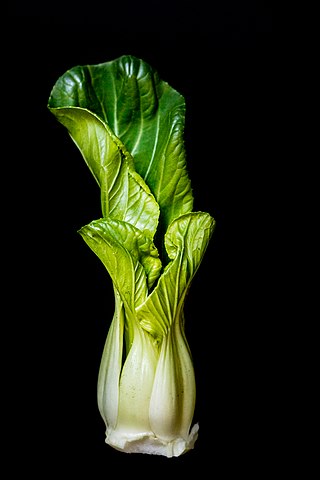
Bok choy, pak choi or pok choi is a type of Chinese cabbage, used as food. Chinensis varieties do not form heads and have green leaf blades with lighter bulbous bottoms instead, forming a cluster reminiscent of mustard greens. Its flavour is described as being between spinach and water chestnuts but slightly sweeter, with a mildly peppery undertone. The green leaves have a stronger flavor than the white bulb.

Gai lan, kai-lan, Chinese broccoli, or Chinese kale is a leafy vegetable with thick, flat, glossy blue-green leaves with thick stems, and florets similar to broccoli. A Brassica oleracea cultivar, gai lan is in the group alboglabra. When gone to flower, its white blossoms resemble that of its cousin Matthiola incana or hoary stock. The flavor is very similar to that of broccoli, but noticeably stronger and slightly more bitter.

Brassica oleracea is a plant species from the family Brassicaceae that includes many common cultivars used as vegetables, such as cabbage, broccoli, cauliflower, kale, Brussels sprouts, collard greens, Savoy cabbage, kohlrabi, and gai lan. The uncultivated form of the species, wild cabbage, is native to southwest Europe.

Brassica juncea, commonly brown mustard, Chinese mustard, Indian mustard, Korean green mustard, leaf mustard, Oriental mustard and vegetable mustard, is a species of mustard plant.
Spring greens are a cultivar of Brassica oleracea in the cultivar acephala group, similar to kale, in which the central leaves do not form a head or form only a very loose one. It is considered to be closer to wild cabbage than most other domesticated forms, and is grown primarily in northern Europe, where its tolerance of cold winters is valued for an early spring supply of edible leaves. The cultivar group acephala also includes curly kale and collard greens, which are extremely similar genetically.

Savoy cabbage is a variety or cultivar group of the plant species Brassica oleracea. Savoy cabbage is a winter vegetable and one of several cabbage varieties. It has crinkled, emerald green leaves, which are crunchy with a slightly elastic consistency on the palate.
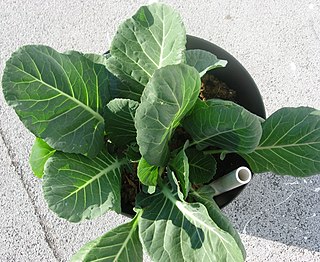
The acephala group refers to any type of Brassica which grows without the central 'head' typical of many varieties of cabbage. These are included within the species Brassica oleracea, such as kale. The name literally means "without a head" in contrast to those varieties known as capitata or "with a head". This group includes a number of species, both wild and cultivated, many of which are grown for their edible leaves and flowers.

Napa cabbage is a type of Chinese cabbage originating near the Beijing region of China that is widely used in East Asian cuisine. Since the 20th century, it has also become a widespread crop in Europe, the Americas, and Australia. In much of the world, it is referred to as "Chinese cabbage". In Australia, it is sometimes referred to as "wombok".

The Jersey cabbage is a variety of cabbage native to the Channel Islands that grows to a great height and was formerly commonly used there as livestock fodder and for making walking sticks. It is also known as Jersey kale or cow cabbage, and by a variety of local names including giant cabbage, long jacks, tree cabbage and the French chour and chou à vacque.



















